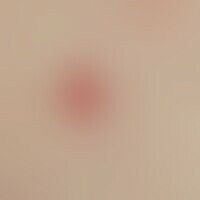Image diagnoses for "Nodule (<1cm)", "red"
182 results with 594 images
Results forNodule (<1cm)red

Keratoakanthoma classic type D23.L
Keratoakanthoma classic type: rarelocalization of a keratoakanthoma otherwise typical of the course (existing for 6 weeks) and clinical aspect

Mycosis fungoid tumor stage C84.0
mycosis fungoides tumor stage: mycosis fungoides known for years. since a few months rapid appearance of plaques and nodules on face and extremities. see preliminary findings from 2013. findings of the same patient in 2017

Old world cutaneous leishmaniasis B55.1
Leishmaniasis, cutaneous. 12 weeks old, 1.5 x 1.2 cm in size, slowly progressing in size, solitary, slightly pressure dolent, red, rough lump with ulceration in the center. History of previous vacation in Egypt. No systemic complaints.

Kaposi's sarcoma (overview) C46.-
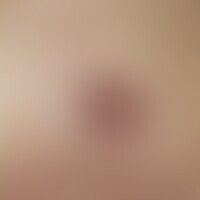
Keratoakanthoma (overview) D23.-
Keratoacanthoma: Solitary, 1.5 cm in diameter, spherically bulging, hard, reddish, centrally dented, strongly keratinizing node on the forehead of an 82-year-old patient; the peripheral, wall-like areas of the node are interspersed with telangiectasias and enclose a central, gray-yellow, keratotic plug.

Angiodysplasia Q87.8
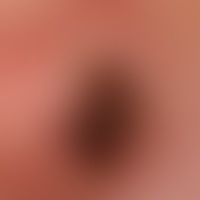
Keratoakanthoma (overview) D23.-
Keratoakanthoma, classic type: short term, grown within a few weeks, about 1.8 cm in diameter, hard, reddish, central keratotic nodule with bizarre telangiectasias on the surface, in a 71-year-old female patient.

Melanoma acrolentiginous C43.7 / C43.7
melanoma, malignant, acrolentiginous. reddish, partly skin-coloured, slowly growing, coarse plaque, which has predominantly displaced the nail bed. there are also bizarre, black-brown hyperpigmentations. the nail plate is no longer existent except for a rest.

Keratoakanthoma (overview) D23.-
Keratoakanthoma, classic type: short term, grown within a few weeks, about 1.8 cm in diameter, hard, reddish, central keratotic nodule with bizarre telangiectasias on the surface, in a 71-year-old female patient.

Primary cutaneous diffuse large cell b-cell lymphoma leg type C83.3
Primary cutaneous diffuse large-cell B-cell lymphoma leg type: nodules and plaques on the lower leg of a 65-year-old woman, which have been present for several months and have been growing rapidly over the last few weeks, partly plate-like, partly nodular, completely painless, surface-smooth.

Swimming pool granuloma A31.1
Swimming pool granuloma. general view: For several months, continuously growing, completely painless redness and gradual plaque formation at the left forefinger base joint of a 60-year-old aquarium owner. 3 cm in diameter, red-livid, with central rhagade, painless, red knot at the base joint of the left forefinger covered with coarse scales.

Lip carcinoma C00.0-C00.1
Lip carcinoma : Broad, firm, painless, warty, roughly indurated, eroded and ulcerated plaque and nodules of the lower lip.

Cylindrome D23.4
Cylindrome: firmly elastic, hairless, red knot with a reflecting surface, interspersed with telangiectasia.
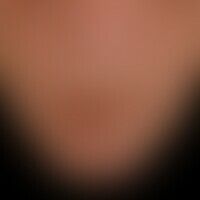
Lip carcinoma C00.0-C00.1
Lip carcinoma: broad, firm, painless, wart-like, eroded and ulcerated plaque with deposits on the lower lip. 74-year-old cigarette smoker.

Keloid (overview) L91.0
Keloids. Apparently spontaneous keloids. No recurrent trauma. No history of acne vulgaris.

Acne papulopustulosa L70.9
Acne papulopustulosa: Coexistence of inflammatory papules and frustrated and older pustules.

Lymphomatoids papulose C86.6
lymphomatoid papulosis: previously known recurrent clinical picture in a 34-year-old female patient. rapid, painless knot formation within 14 days. this finding healed spontaneously scarred under central necrosis after 3 months. below the large knot a recently formed new focus.
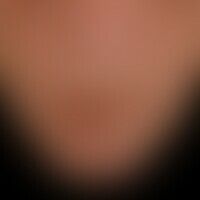
Carcinoma of the skin (overview) C44.L
Carcinoma of the skin: a continuously growing lip carcinoma that has existed for years.

Merkel cell carcinoma C44.L
Merkel cell carcinoma: detailed image of a rapidly growing, symptomless red node.

Basal cell carcinoma nodular C44.L
Nodular, extensive ulcerated basal cell carcinoma. since >10 years slowly growing exophytic, non-painful, fleshy tumor which was covered with a compress. marked with arrows, a glassy border wall which is (still) characteristic for advanced basal cell carcinoma.


